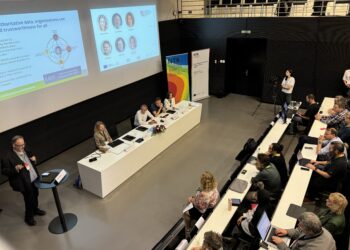
I first met Michael Bierut as part of a major journal redesign project back in the early 2000s. He joined a strong team out of William Drenttel’s Winterhouse studio in Connecticut. In addition to completely redesigning a prominent journal, we brought in a customized version of a relatively young typeface (Quadraat), with the type designer himself modifying certain characters to increase legibility and readability given the specialized nature of the content and the lettering involved in that particular brand’s wording. It was a memorable and happy experience.
Michael has been a major force in design in the US, and beyond. He was the president of the American Institute for Graphic Arts (AIGA), is a senior critic in graphic design at Yale, a partner at Pentagram Design in New York City, a founding writer for the Design Observer blog, and a driving force behind the film “Helvetica.” He travels often, and was most recently in South Africa on a project.
Because typography has been a subject of great interest in the Kitchen lately, and because, like me, Michael also wrote an essay in response to Errol Morris’ experiment suggesting that Baskerville is the most believable typeface, I prevailed upon him to participate in an email interview, with topics covering typographic design, how page design and venue interact with type choices, how type influences perceptions, whether we’ll ever “break the page,” and why the Higgs Boson was announced via a PowerPoint that relied on Comic Sans.
Q: What is the purpose of good typography?
A: Good typography, first, makes words readable. At its best, it does something more: it helps express the animating spirit of the ideas behind the words.
Q: I often feel people take type for granted. But if you were to design a new typeface from scratch, how many different characters would you have to draw? And what proportion of those would exist mainly to serve scientific and mathematical notation?
A: Usually, I feel people should take type for granted. After all, if typography is calling attention to itself, it’s taking that attention away from what the words are saying, which I don’t think is usually a good thing. But you’re right in implying that most people have no idea how much goes into designing a typeface. Twenty-six letters in the alphabet, usually with two versions of each, upper and lower case. Punctuation and alternate characters and numbers — let’s not forget numbers — can add another 40 or so. I’m not an expert in typefaces that serve scientific writing, but I’d guess that’s another dozen or two. So you’re talking about over one hundred elements, one hundred little pieces. Each one of them has to stand its own. Yet they all have to go together to create a harmonious reading experience. That’s what makes type design such a lovely intersection of art and science.
Q: Type is all around us, perhaps more than ever as we’ve become a more machine-writing culture over the past decade or two. But type exists in a venue, and each venue has a purpose. For instance, you point in one of your essays to an analysis of the typographic design of ballots. Voters aren’t necessarily aware they are dealing with a very specific and undesigned typographic composition when they vote. Can you talk a little about how type can subtly influence behavior, emotion, and perceptions?
A: Yes, there was a time when most people had a choice between two kinds of personal communication, handwriting or using a typewriter. Today, people are invited to choose from a list of (surprisingly exotic) typefaces every time they turn on their computer. I think this has made everyone more aware of the idea that picking a typeface is a conscious choice. Certain kinds of typeface design and typographic design are designed to persuade: we can make this company look modern if we use a crisp sans serif typeface, or we can make this restaurant look like its been around forever if we use typefaces and layout styles that have been around forever too. But there are other categories, and ballot design is one of them, where the goal should be to be purely functional. There have been notable failures in this category. The design of the notorious Palm Beach County “butterfly ballot” in the 2000 Presidential election is certainly one of them. But I would say most of the time this is less about a conscious attempt to manipulate an outcome, and more about pure ineptitude.
Q: Purposeful typography has deep roots. Many typefaces were commissioned to solve very particular problems or achieve very particular goals. Italic was originally invented to save space, and thereby became a favorite of lawyers, if I remember correctly. Now, it’s used for emphasis, and lawyers user ALL CAPS for emphasis (or simply to induce a coma in the reader). Are there any typographic conventions that evolved in the service of science and mathematics that we take for granted today?
A: I think once the artistic world of the type designer merged with the scientific world of the computer programmer, you began to see this crossover. For instance, I assume those “carrots” we have on our keyboards were there originally to express “greater than” and “less than.” Then they were adopted by coders, and now they show up all the time in the way email addresses are constructed. At least I think that’s what happened.
Q: In scientific publishing, the PDF remains a favorite mode of receiving information. Entire services like Mendeley are built on sharing PDFs, for instance. Why do you think composed and typeset pages have held their appeal? Do you imagine this changing?
A: We use the word typography to describe two different things: the design of letterforms, and the layout of typeset passages on a page. Both of those experiences are really important to communicating information, especially when that information involves complex ideas. A simple MS Word document, or a Powerpoint presentation, has its limits, particularly the unpredictability in how the page will actually display. With a PDF, you are locking down all those variables.
Q: Readability and legibility are big issues, along with efficiency and avoiding reading fatigue. How do you measure these in the real world? How much is type, how much page design, and how do the two interact?
A: The studies I’ve seen about readability and legibility tend to focus on a specific set of metrics: size, not just the point size, but things like the size of the lower case letters as a proportion of the overall letter height, and line length. People simply can’t read really small type set in really long lines. It’s the same way they can’t climb long flights of badly spaced stairs with no landings. That part is almost physical in its nature.
Q: I keep seeing notions that we will someday “break the page,” so to speak — find a useful way to deviate from the proportions of the books with which we are so familiar. Some complain we’ve just been trained to prefer these formats, or they are ingrained because they’re easier to manufacture. Yet, with some slight variations, they are quite common around the world, and even the iPad and Kindle hew to them. In your opinion, is there a physiological basis that informs page design and typography? How much of design is “designing to physiology”?
A: This part is much more about habituation. We get used to things, and we like reading the way we’re used to reading. I believe sans serif typefaces — today upheld as models of neutrality and legibility — were called “Grotesques” in the 19th century because people thought they were hideous. But now we’re used to them. It’s hard to predict what will happen as reading on screen becomes more of a universal norm, and when the formats dictated by social media — Twitter’s 140-character limit, for instance — start to influence what we’re used to.
Q: The Higgs Boson — perhaps the most important scientific discovery of the past 50 years — was announced via a PowerPoint deck that used the Comic Sans typeface extensively. Why do you think the scientists chose this? Was it a wise choice?
A: Well, as I understand it, the scientists at CERN were actually surprised that people commented on this. Reportedly Fabiola Gianotti, the coordinator of the CERN program to find the Higgs Boson, was asked why she had selected Comic Sans. She simply said, “Because I like it.”
Q: Authority is something scientific journals try to convey at the article level, usually using page design and typographic conventions that fit preconceptions of what scientific articles should look like. Have you ever seen an instance when either authority was achieved falsely through type, or when authority was not granted because of errors in typography?
A: Well, if you can announce the Higgs Boson in Comic Sans, clearly anybody can do anything. I actually think it almost works the other way sometimes: making a college textbook, say, look really “user friendly” tends to also make it look less “serious,” even if nothing changes other than the design treatment. Designs that have a whiff of complex impenetrability tends to suggest big, complicated ideas. Academic writing tends to work the same way, I understand.
Q: Helvetica was recently discussed in a blog exchange as “boring.” You’ve been in a movie about the same typeface. Is it boring? Is it suited better for certain applications and not for others?
A: It’s a cliché, but typefaces are really just ingredients. a good cook can make something amazing out of even the blandest ingredients. Still, you don’t want to eat the exact same dish every day.
Q: One hundred years from now, do we still need typographers?
A: I think their jobs may be completely different, but since the advent of the written word, there have been people who have decided to worry about it. It was stone carvers in ancient Rome, scribes in the Middle Ages, all the way through Gutenberg to the present day. That’s a pretty long track record. More likely we may reach a point where each one of us is a typographer with our own custom proprietary typeface.
Q: One last question — What is your favorite typeface of all time, and why?
A: I grew up in a Cleveland suburb called Parma, Ohio. Somewhere along the way I fell in love with a typeface called Bodoni. It turns out that Giambattista Bodoni had his foundry in Parma, Italy. So I pick Bodoni because us guys from Parma have to stick together.
Discussion
4 Thoughts on "Interview with Michael Bierut — Typography, Modern Applications, and Timeless Communication Challenges"
“ So you’re talking about over one hundred elements, one hundred little pieces.”
Wrong Mr. Bierut, a professionally made font starts from 250 glyphs and can easily go up to 1000 (having Latin languages only)
Kent,
I liked your article and its suggestion of the power of image and text: they become more than the sum of their parts. How funny that here the text is the image and the image is the text. Coming out of years of publication management and production, I love to read of how these two bolster each other up: the font gives me content and image in one. And, ideally, they should be One. You’ve described this symbiotic link very clearly . . . a pleasure to read
peace,
mickey morgan
TheKarmaPress.com



